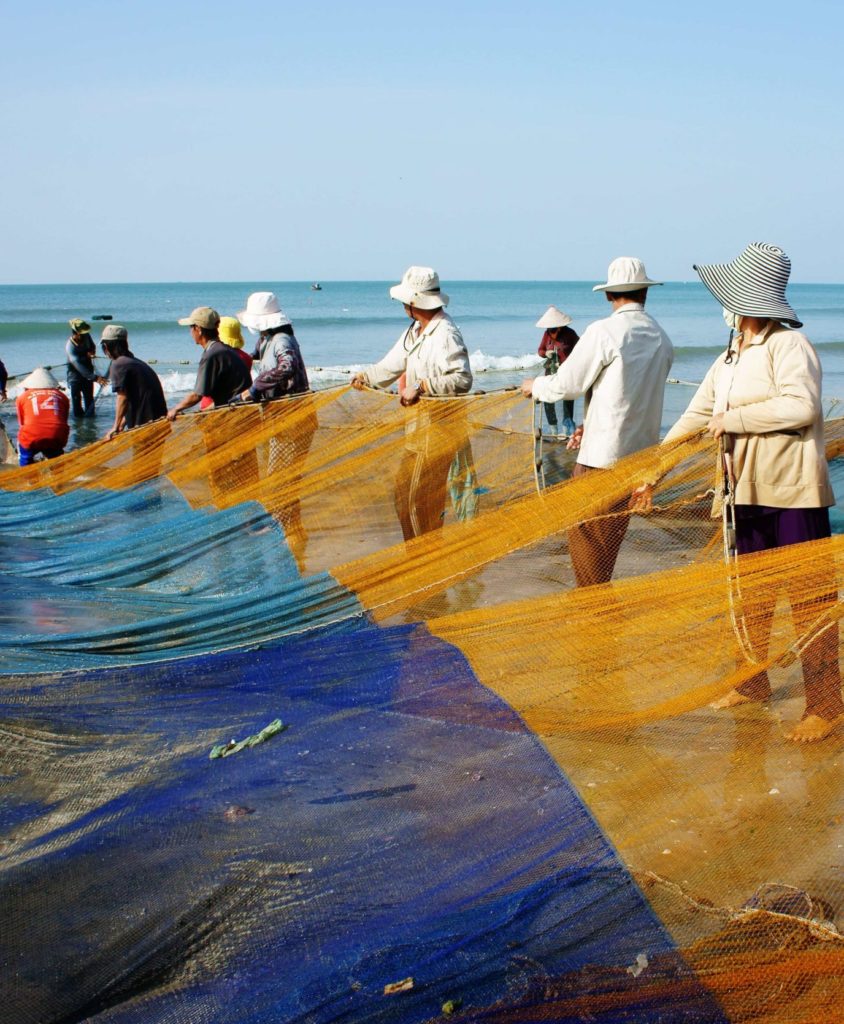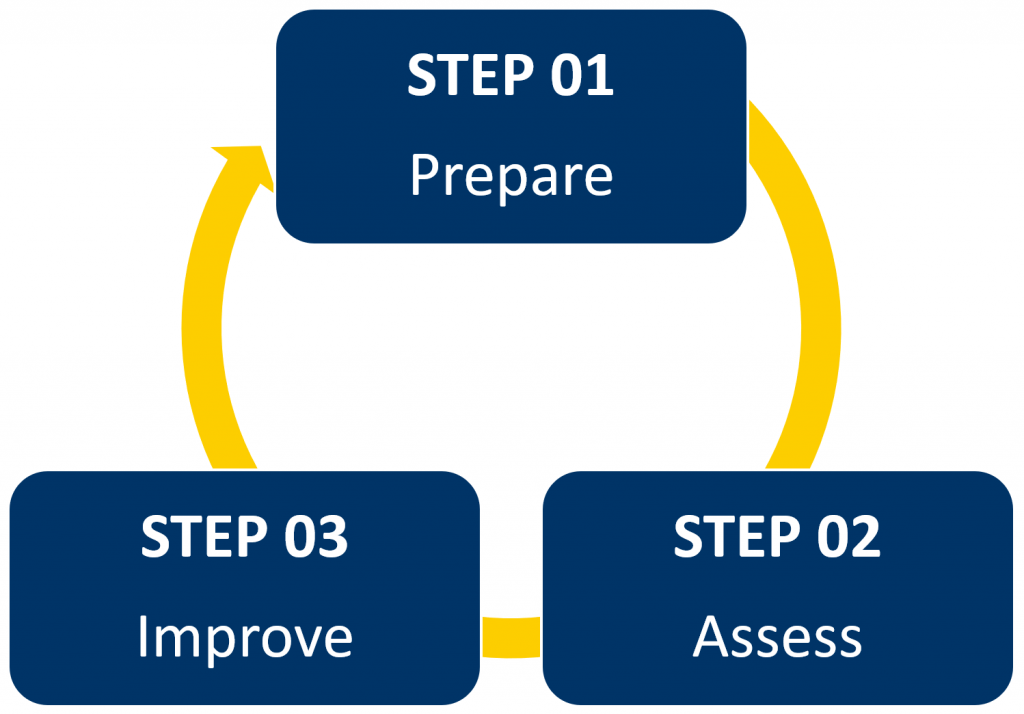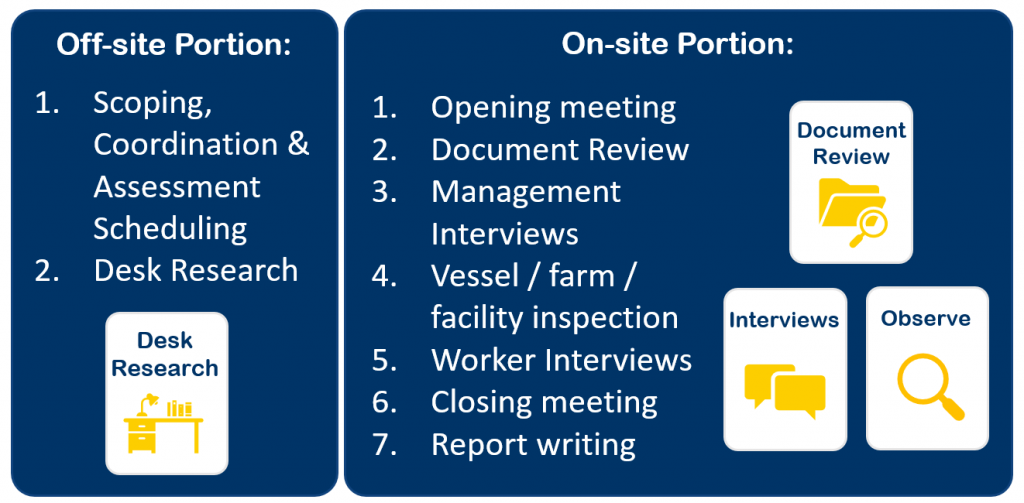Topic
Implementing the Social Responsibility Assessment (SRA) Tool


The following steps outline a general process of the implementation of the SRA:

It is important as you prepare for the SRA that you understand:


Why have you decided to implement the SRA? What are you trying to achieve? Some examples include:
There is no one answer to the WHY, but this should be determined before an assessment begins to ensure the scoping of sites and SRA requirements is fit for purpose.

Who will you be evaluating? Which sites are included? This could be vessels, shore-based fishers, processing facilities, aquaculture farms, or a combination. You’ll also need to know how many workers there are at identified sites to make sure an adequate sample of workers are interviewed in the assessment. In the SRA, this is known as the Unit of Assessment.

Where are your sites located? The following are some key elements to take into consideration:
Results are processed at the level of the Unit of Assessment. Sites in different countries/regions, or even communities that are geographically far away, may face very different challenges and therefore, different levels of risk on certain indicators, therefore there are many factors that should be taken into consideration when defining the Unit of Assessment.

What will be the focus of the assessment? Depending on the objective of the assessment (your WHY), you may decide to assess all 24 SRA indicators or you might focus on only a subset of those indicators.
In order to gain a complete picture, it is strongly recommended to consider assessing against the entire SRA. If circumstances prevent a full assessment, you could consider staggering out the assessment of different principles, components, or indicators over time to reduce costs and any logistical difficulties.

When will you conduct the assessment? Decide on a timeline for when you would like the assessment to be complete. Some guidelines on choosing timing:

How will you conduct the assessment? Depending on your WHY, implementation of the SRA may take different forms. The most effective assessments are completed by individuals or teams with proper qualifications. For internal programs, there may be internal staff dedicated to conduct assessments. Where third-parties request an assessment, they may require specific assessors / assessment teams to meet certain qualifications.
The cost of an assessment can be drastically different depending on the scope of the assessment and the assessor / assessment team. It is important to identify the source funding to cover the costs of the assessment. Furthermore, it is recommended to conduct follow-up assessments each year, which should also be taken into consideration for future funding.
TRAINING
Before conducting an assessment, an assessor or implementer should deepen their knowledge of the issue areas covered in the SRA and gain an understanding of the key elements of conducting a social assessment.
There are several resources to help stakeholders prepare for an assessment, whether an implementing manager or an assessor / assessment team:
Training Modules – Approaches to Gathering and Validating Data in Social Responsibility
–
The Social Responsibility Assessment for the Seafood Sector: A Manual for Trainers on Guidance for Assessment Implementation
ASSESSMENT COMPONENTS
Once you have a good grasp on the key issue areas covered and understand what it takes to conduct a social assessment, it’s now time to get acquainted with the SRA to better understand what evidence you’ll need to collect and how to collect it.
There are four main components to an assessment:

Desk research can be conducted before the on-site portion of the assessment, and document review, interviews, and site observation will take place on-site. Understanding what evidence you’ll need for the SRA ahead of time is key to make sure the assessment goes smoothly.
The following resources can be used during the Preparation step:
Social Responsibility Assessment Tool for the Seafood Sector: A Guide to Data Collection
English | Bahasa | French | Spanish
This document outlines the types of data collection and provides examples of where to find the data needed for each SRA indicator during the assessment.
–
SRA Assurance Guidance
This document walks you through key components of the Preparation and Assessment steps, highlighting best practices, and includes instructions on scoping, sampling, scheduling, and more. It also provides an in-depth overview of what is needed to ensure the assessor / assessment team are qualified to undertake an SRA.
–
SRA Unit of Assessment Guidance
This document provides guidance on how to determine the Unit of Assessment based on certain characteristics and the purpose of the assessment.
–
SRA Duration Calculator
This Excel template helps to calculate a recommended assessment schedule for the SRA. This is meant to be a starting point on which to build, and flexibility should be built into the schedule according to other characteristics.
Once you’ve scoped and planned the assessment, and feel prepared to undertake the assessment, it’s time for the SRA.
An SRA generally will take place according to the following steps:

Following the assessment, the results can help devise actions to drive improvement. This improvement plan should be a worker-driven approach, whereby fishers and workers are informed of the results and are consulted on ways to improve.
During the assessment, there are some tools can be filled out as you go to simplify implementation:
SRA Tool Assessment Template
This Excel template can be used throughout the SRA process to collect information about the Unit of Assessment, record data during the assessment, calculate final results and export a final report, and begin to plan improvements based on the SRA results.
SRA Toolkit
This toolkit can be used in the preparation stages of an assessment and during the assessment and helps guide the user through data collection.
Toolkit | Video Tutorial | Slides
Qualified Assessors
On this page you will find details about where to find qualified assessors to undertake the SRA or apply to be recognized as a qualified assessor.
Once you’ve finished your assessment, you’ll know which issue areas have the highest risk. Based on those findings, a plan should be created to address the issues that were revealed.
An effective Improvement Plan includes the following:
Accountability is important to enable an effective Improvement Plan.
–
There may be a lot of findings that need to be addressed, and this can be overwhelming if you don’t prioritize. Prioritization should take into consideration the level of risk, the actions that are needed, and costs, among others.
–
This technique will help you to better understand the findings from the assessment. It aims to reveal the factors that caused or contributed to a problem, which is important to understand when developing and Improvement Plan.
–
Once you have gotten to the root of the finding, conducting research in the area will better inform actions to be taken. There are a number of resources that are available to support on certain topic areas:
–
Fishers/workers are directly affected by the changes that will be made, and they know better than anyone what the issues are. They may also have helpful insights on what changes can be made to the workplace to improve their overall well-being. Discussing the results with fishers/workers is an important step to drive improvement.
–
Actions cannot be vague – be sure to be specific when deciding what actions will help you to mitigate the risks identified in the SRA.
As the SRA has been deployed across different scales of fisheries, farms, and processing sites, guidance has been developed to streamline implementation of the SRA in those contexts.
These interpretation documents provide users with line-by-line guidance on how to interpret the SRA as it is currently written for different types of Units of Assessment.
The current iteration of these interpretation documents were informed via research and stakeholder engagement (workshops and 1:1 engagement).
They are being published in draft form at this time pending additional stakeholder outreach directly with fishers, farmers, and workers.
DRAFT SRA Small-scale Fishing Interpretation
DRAFT SRA Aquaculture Interpretation
DRAFT SRA Processing Interpretation
We encourage those conducting SRAs in any of these contexts to reference these documents for your assessment. If you happen to use one of these documents to conduct an SRA, we would like to hear from you. Please email any comments or feedback to SRAsupport@elevatelimited.com.
Enter a few details about yourself to view this resource.